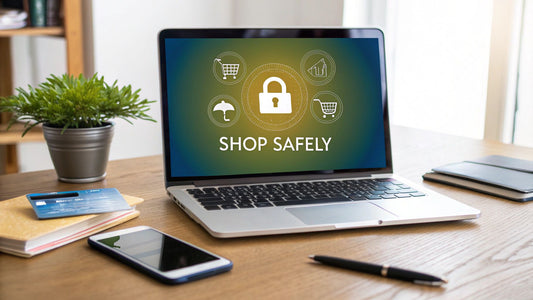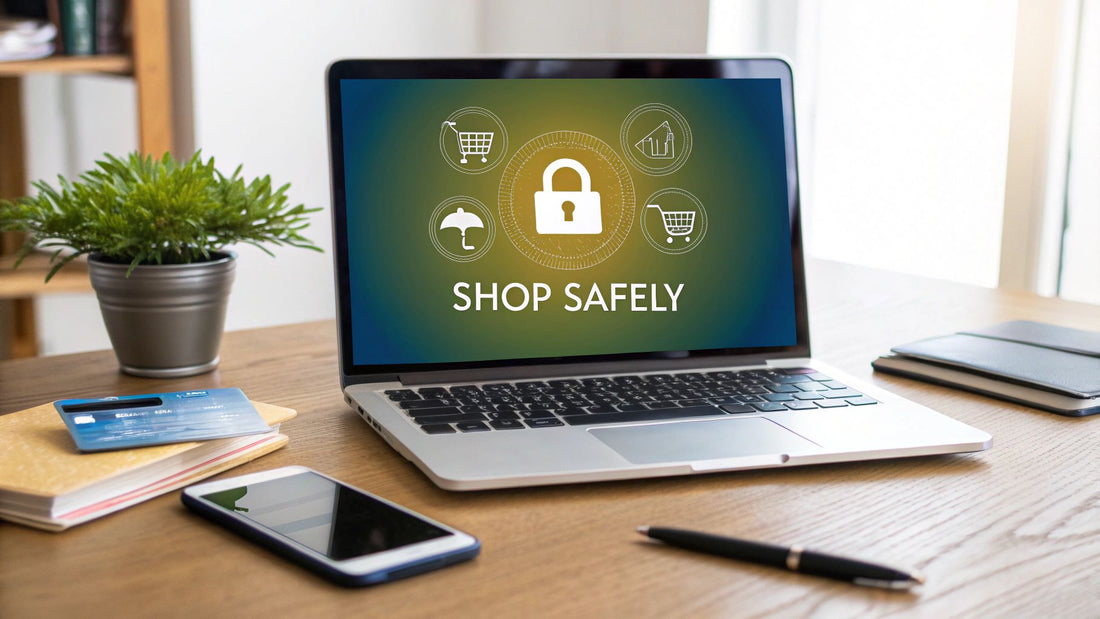
Your Ultimate Guide on How to Shop Online Safely and Avoid Scams
Share
Before you click that irresistible "Buy Now" button, you need to run a quick mental checklist. This isn't just a smart habit; it's your personal security detail in the wild west of online shopping. Protecting yourself, your data, and your money from predators isn't paranoia—it's power.
The secret to staying safe boils down to four non-negotiable actions: verify your seller, secure your connection, use protected payment methods, and guard your personal information like a hawk.
Key Practices for Safe Online Shopping
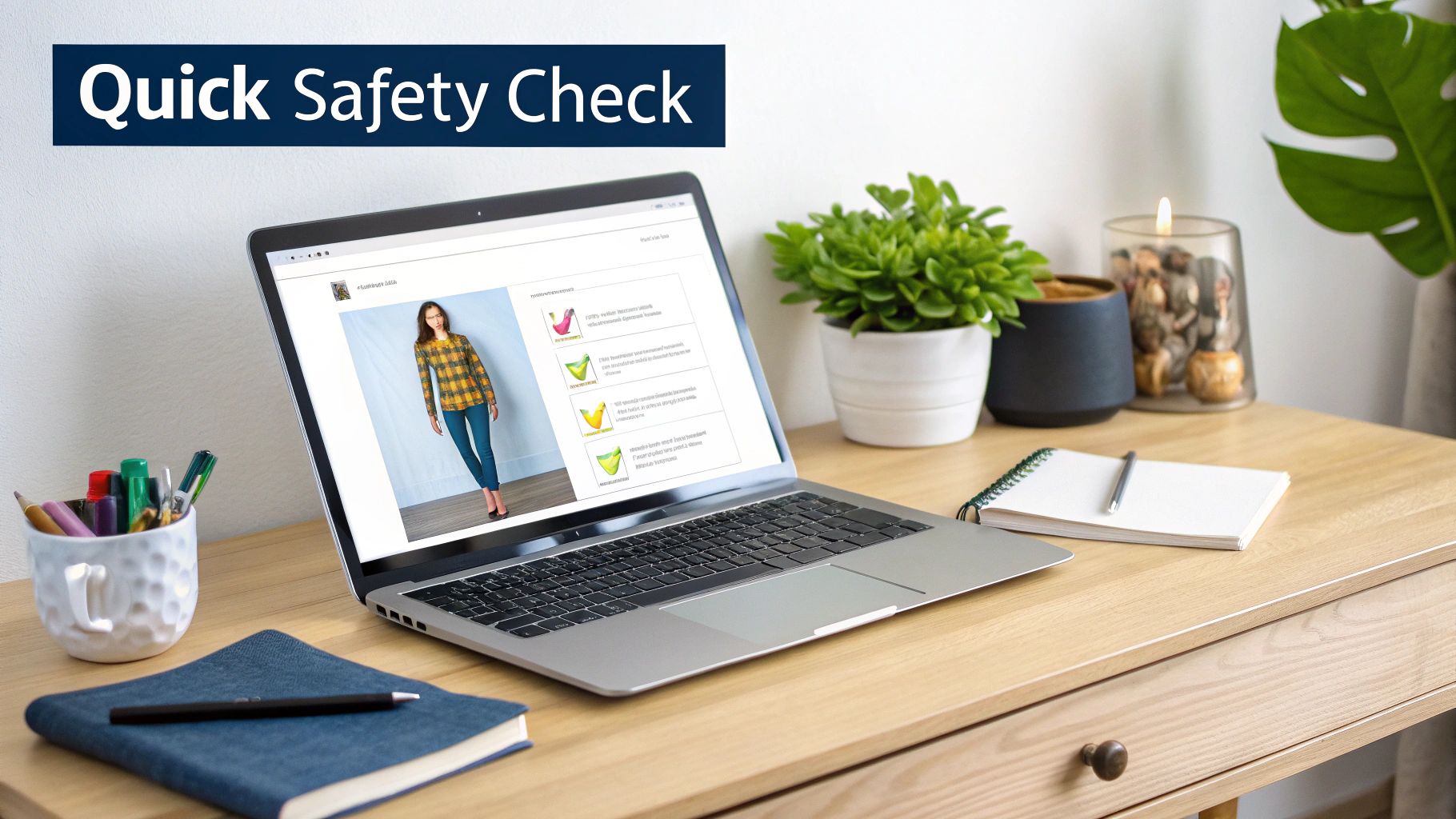
We've all been there—that rush of excitement before a purchase makes you want to speed through checkout. But taking just 30 seconds to run these checks can save you from a world of financial pain and identity theft. Here's your definitive guide—memorize it, use it, and never shop without it.
Your Quick Safety Checklist Before Checkout
This table isn't just a suggestion; it's your go-to defense against online threats. Master these checks before you finalize any purchase and you'll immediately spot red flags and shop with bulletproof confidence.
| Security Check | What to Look For | Why It's Critical |
|---|---|---|
| Seller Verification | Authentic website address, clear return policies, and a real physical address. | You must avoid imposter sites and outright scams designed to drain your bank account. |
| Connection Privacy | The little padlock icon (HTTPS) in your browser's address bar. | This is your only guarantee that your payment details are encrypted and can't be stolen by criminals snooping on the network. |
| Payment Protection | Credit cards or services like PayPal that offer strong fraud protection. | These methods are your financial safety net. They make it easy to dispute fraudulent charges and get your money back. |
| Data Minimization | Only filling out the absolutely necessary fields at checkout. | The less information you share, the less you have to lose if the company's security is breached. Don't give them what they don't need. |
Once you force yourself to do this, these checks become second nature. You'll start spotting potential threats instantly, transforming from a potential victim into a savvy, protected shopper.
Check Who You're Buying From
Scammers have become masters at creating websites that perfectly mimic legitimate stores. Always double-check the website address for tiny typos or weird extensions. A legitimate business will have a physical address listed and a clear, easy-to-find return policy. If it feels off, it is. Bail immediately.
Make Sure Your Connection is Private
Never, ever enter payment information when you're on public Wi-Fi at a coffee shop or airport. These networks are a playground for hackers. The safest move you can make is to switch to your phone's cellular data or use a trusted VPN to encrypt your connection. Don't risk it.
A friend of mine once dodged a major scam just by noticing the little padlock icon was missing from the checkout page. That small detail saved their credit card info from being stolen.
Pick Protective Payment Methods
When paying online, credit cards are your best and only smart choice. They offer robust federal fraud protection, meaning you are not liable for unauthorized charges. Digital wallets are another powerful option. For a site you're unsure about, use a one-time virtual card number if your bank offers it. It’s the ultimate defense.
Guard Your Personal Information
Adopt a minimalist mindset at checkout. Provide only the information absolutely required to complete the purchase. And never, under any circumstances, save your payment details on shopping sites, no matter how convenient it seems.
Make these habits stick starting today.
- Check your bank and credit card statements weekly to catch fraudulent activity early.
- Keep your browser, phone, and computer updated. These updates contain critical security patches you can't afford to ignore.
- Before buying from a new seller, read recent customer reviews. They will quickly reveal if the business is legitimate or a front for a scam.
Just last month, another friend was about to buy a gift from a new online boutique but noticed the billing address form looked strange. They backed out, found the item on a well-known retail site, and avoided losing $200 to what was likely a fake storefront.
Don't wait for a costly mistake to teach you these lessons. Integrate these simple checks into your routine now. Whether you're filling your cart at TeddyPaws or grabbing a deal elsewhere, this diligence gives you the peace of mind you deserve.
Your security is worth the extra few seconds. Act on it.
How to Vet Retailers Before You Add to Cart
A polished website means nothing. Scammers are masters of disguise, building storefronts that look just as professional as your favorite brands. Before you even think about giving a new retailer your payment details, it’s time to put on your detective hat and take action.
Your first move is to scrutinize the URL. This is about more than just finding the 'https' padlock. Look closer. Are there subtle misspellings of well-known brands? A weird domain extension like ".biz" instead of ".com"? These are classic red flags signaling a clone site built to steal your info.
Dig Deeper Than the Homepage
A real business has nothing to hide. Go straight to their "Contact Us" or "About Us" page. Don't settle for a generic contact form. A legitimate company will list a physical address and a customer service phone number. You can see a great example of this transparency at https://teddypaws.co/pages/about-us—this is what a trustworthy brand looks like.
If that information is missing, it's a huge warning sign. If a store won't tell you where they are or how to call them, you cannot trust them with your money. Next, hunt for their return policy. A clear, fair, and easy-to-find return policy is a massive green flag. It proves the company stands behind its products.
Look for Social Proof and Third-Party Reviews
Never take the store's word for it. Those glowing five-star reviews on their site can be faked in minutes. You must step off their website and see what the rest of the internet is saying.
Verify the company’s reputation on third-party sites now.
- Search the business on the Better Business Bureau (BBB). Check their rating, customer complaints, and how the company responded.
- Check their social media. A real brand will have an active presence with a history of posts and genuine interactions. A social media page that looks like a ghost town is a sign that the "business" is a temporary scam.
Online fraud is a constant threat, with 81% of shoppers acknowledging it's a common problem. That makes consumer trust priceless; 83% of people are more likely to buy from websites that are transparent about how they prevent fraud. Doing your homework isn't just smart—it's essential for your financial safety.
Trust your gut. If a deal seems too good to be true—like a brand-new iPhone for $100—it is. Fraudsters prey on our desire for a bargain. Understanding the strategies for preventing counterfeits and online fraud that real businesses use will sharpen your instincts. Your own diligence is the best weapon you have.
Mastering Secure Payments at Checkout
The checkout page is the danger zone. This is the moment your money is most exposed—the digital equivalent of an armored truck transfer. You need to be on high alert. Nailing your payment strategy isn't just a good idea; it’s your best defense against financial theft.
Choosing the right payment method is your first, most powerful move. Not all options are created equal, and knowing the difference will save you from a world of hurt. This isn't just about paying; it's about paying smart.
Your Payment Method Matters Most
Let's be crystal clear: credit cards must be your default payment method. When you use one, you're spending the bank's money, not your own. Federal law caps your liability for phony charges at just $50, and most major card issuers have zero-liability policies. If a scammer gets your card details, your actual bank account remains untouched.
Debit cards are a direct pipeline to your cash. If those numbers are compromised, real money can be drained from your account in an instant. Getting it back is a slow, stressful nightmare you must avoid at all costs.
My rule is simple and non-negotiable: Credit over debit, always. This one choice creates a vital buffer between a thief and your personal finances, giving you breathing room to dispute charges without losing your own money.
Ready to level up your security? Use a digital wallet or a virtual card number.
- Digital Wallets (PayPal, Apple Pay): These services act as a fortress for your data. When you pay, the retailer gets a unique, one-time transaction code—not your actual card number. This process, called tokenization, means that even if the retailer has a data breach, your primary financial details are never exposed.
- Virtual Card Numbers: Many credit card companies now let you generate a temporary, single-use card number for a specific purchase. Once that transaction is done, the number is useless. It’s a complete dead end for any hacker.
Here’s a look at how a service like PayPal positions itself as that secure go-between, keeping your card details hidden from sellers.
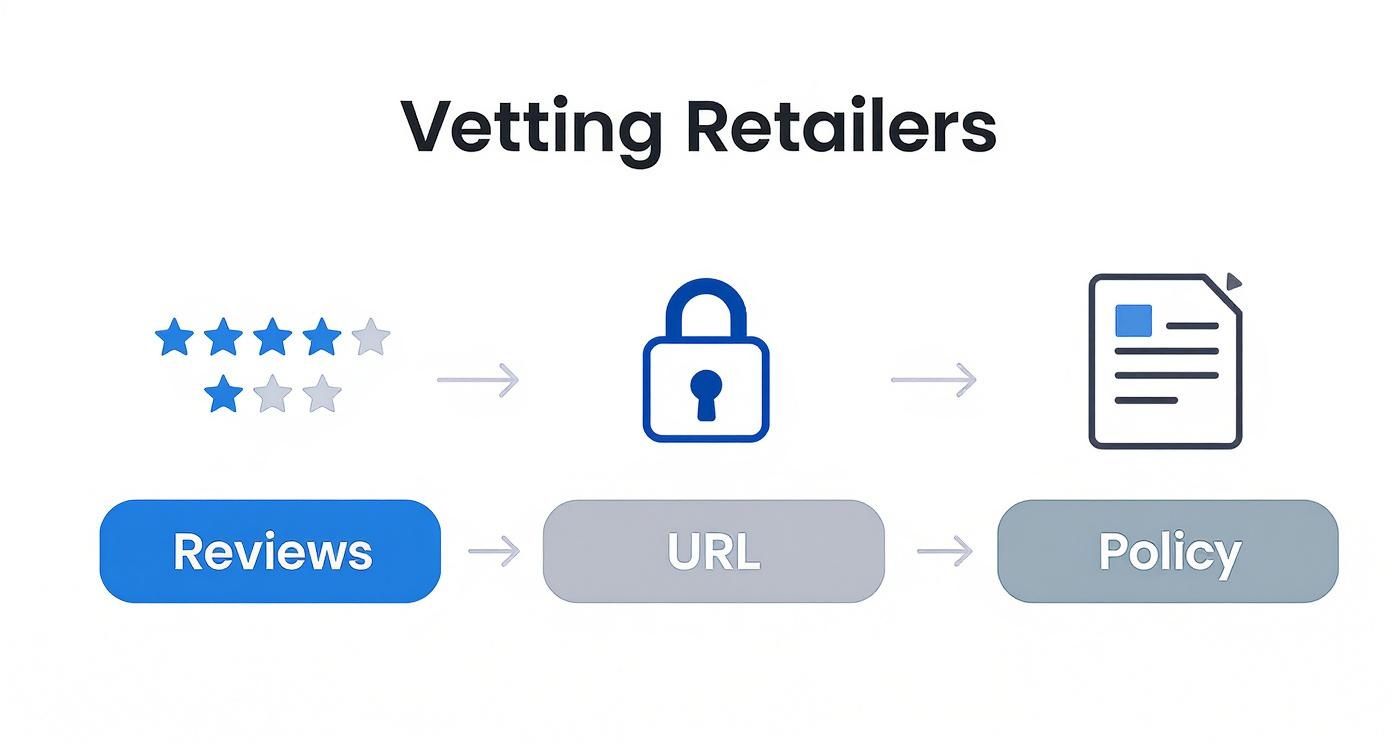
When you see that familiar interface, you know your payment is being handled without ever handing your raw card number over to the merchant.
To help you decide, here’s a quick breakdown of the most common payment options and how they stack up.
Comparing Online Payment Methods For Security
Not all payment methods offer the same level of protection. This table compares the heavy hitters to help you make the safest choice at checkout.
| Payment Method | Fraud Protection Level | Best For | Key Consideration |
|---|---|---|---|
| Credit Cards | High | Most online purchases, especially from new retailers. | Your liability is capped at $50, with many issuers offering $0 liability. You're using the bank's money. |
| Digital Wallets | Very High | Any transaction where you want to avoid sharing card details. | Tokenization keeps your actual card number hidden from the merchant, adding a strong layer of security. |
| Virtual Cards | Highest | One-off purchases from unfamiliar sites or for free trials. | The card number becomes useless after a single transaction or a set time, making it hacker-proof. |
| Debit Cards | Low | Use only as a last resort. | A direct link to your bank account. Recovering stolen funds can be a slow and difficult process. |
Using a credit card, digital wallet, or virtual card gives you a powerful advantage. Debit cards, while convenient, simply carry too much risk for online shopping. Make the smart choice.
Spotting a Compromised Checkout
Even with the best payment method, you must stay vigilant. Scammers create fake payment gateways that look identical to the real thing but are built for one purpose: to steal your info.
Here’s a hard and fast rule: never, ever save your payment details on a merchant’s website. It’s convenient, but it’s not worth the risk of having your data exposed in a hack. Always check out as a guest. It minimizes your digital footprint.
While you're at it, secure the entire journey of your purchase. You need to consider adding shipping protection to your order, which gives you critical peace of mind once the package leaves the warehouse.
Fortifying Your Devices and Digital Identity
Real online security doesn't start on a retailer's website—it begins on the device you're holding. Before you even think about adding an item to your cart, your own digital fortress must be locked down.
These aren't just "shopping tips." They are foundational habits that protect you everywhere online, making you a much harder target for criminals.
First, and this is non-negotiable, keep your software updated. Those reminders to update your browser and OS aren't just for new features. They are plugging critical security holes that hackers are actively hunting for. Running on old software is leaving your digital front door wide open. Update now.
Shopping without reputable antivirus software is a massive gamble. A good security suite is your personal bodyguard, constantly scanning for malware designed to skim your financial info right off your device.
Beyond Basic Passwords
The old advice to “use a strong password” is dangerously outdated. The real threat is using the same password everywhere. A data breach at one company instantly puts all your other accounts at risk. You must stop doing this immediately.
This is why a password manager is an absolute game-changer.
These tools generate unique, impossible-to-guess passwords for every site and store them in an encrypted vault. All you have to do is remember one master password. It's the single biggest security upgrade you can make.
Another powerful move is to switch on multi-factor authentication (MFA) wherever it's offered. MFA adds a second layer of security, usually a code sent to your phone. Even if a thief steals your password, they can't get into your account without your phone.
It's no surprise that 70% of people believe it's harder to secure their digital information than their own home. With cyberattacks causing $9.5 trillion in losses last year, the threat is real and growing. You must take it seriously.
The Hidden Dangers of Public Wi-Fi
Hopping on free Wi-Fi at a coffee shop is one of the riskiest things you can do online. These networks are unsecured, a perfect hunting ground for criminals to intercept your data—from credit card numbers to logins.
If you absolutely must make a purchase on a public network, using a Virtual Private Network (VPN) is essential.
A VPN encrypts your entire internet connection, creating a secure, private tunnel for your data. It makes your activity invisible to anyone snooping on the network. It's an invisibility cloak for your online activity.
For a deeper dive into protecting your entire digital life, you must read up on these essential tips for protecting personal information online.
Spotting and Avoiding Advanced AI Scams
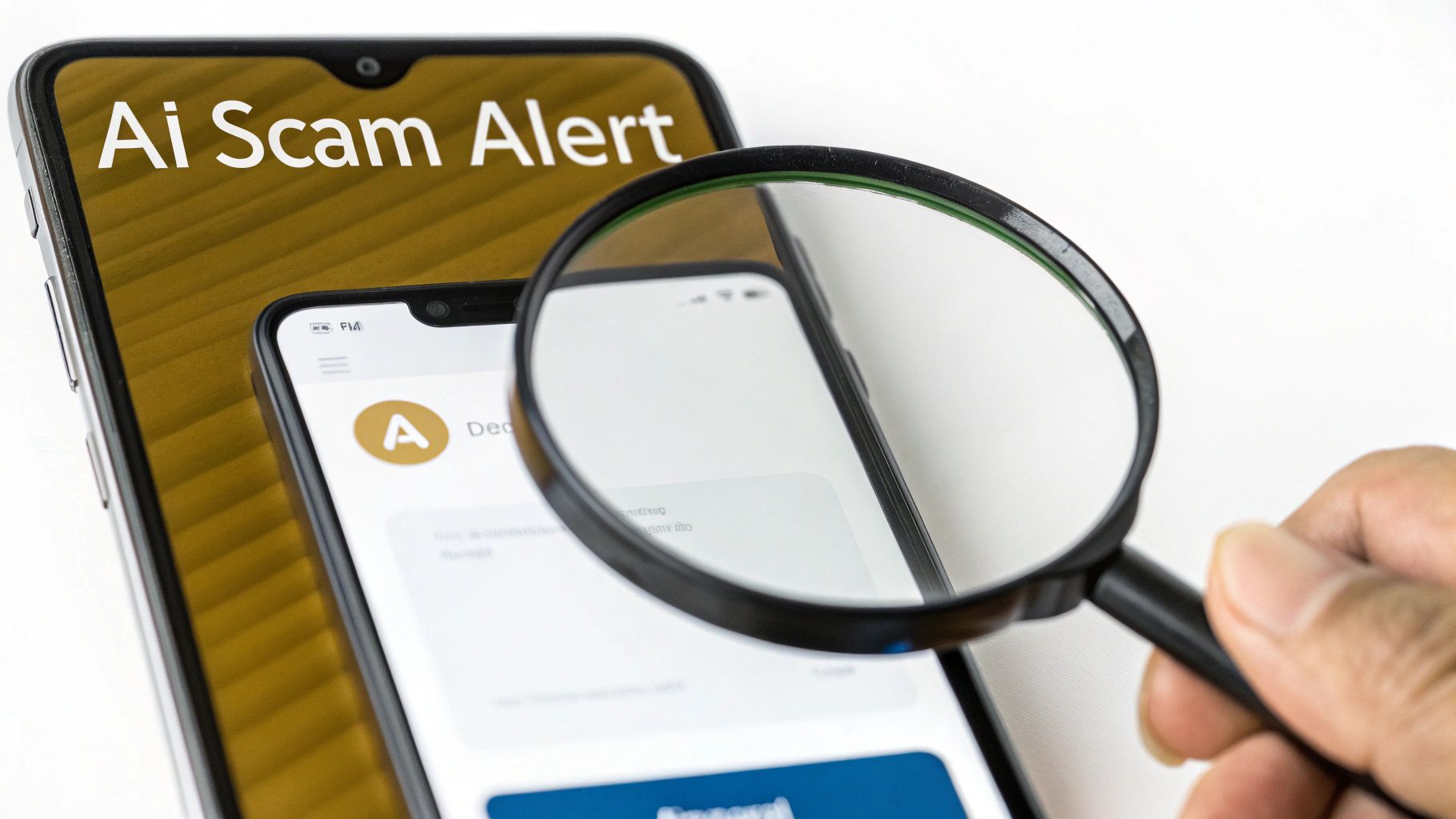
The game has changed. The clumsy phishing emails we used to laugh at are gone, replaced by something far more dangerous. Scammers are now using artificial intelligence to build threats so convincing they can fool anyone. This isn't a future problem—it's happening right now.
To shop safely, you have to understand these next-level tactics. Generative AI creates perfect marketing emails and clones websites that are nearly impossible to distinguish from the real thing. It has supercharged online fraud, making it more critical than ever to know what you're up against.
The New Face of Online Deception
Let's be clear: AI-powered fraud is exploding. A shocking 91% of ecommerce merchants are worried about the rise of AI-enabled fraud. Scammers are using AI to write phishing emails that sound just like your favorite brand and deploy bots that act exactly like real customers, making their schemes incredibly difficult to spot. For a deeper dive, explore insights on ecommerce risk trends.
You can no longer just look for bad grammar. The threat is more sophisticated, and so your defense must be too.
How to Outsmart the AI Scammers
The good news is that even advanced AI isn't perfect. It can't quite replicate the human touch, and if you train your eye, you can spot the subtle signs that something is wrong.
Always look for these common AI slip-ups:
- Unusual Urgency: AI scam emails create a frantic, over-the-top sense of urgency. They pressure you into clicking right now with threats of a security breach or account closure if you don't "verify" your details. Real companies don't communicate this way.
- Emotionally Flat Language: The message might be grammatically flawless, but it can feel strangely soulless and generic, lacking the personality you'd expect from a brand you love. If an email reads like a robot wrote it, it probably did.
- Hyper-Personalization Gone Wrong: AI might pull your name and past orders to seem legit, but sometimes it gets details wrong, like an incorrect order number. It creates a weird feeling where the message seems both personal and inaccurate.
The most powerful tool you have against AI scams is a healthy dose of skepticism. If an offer or an email just feels off, trust your gut. Pause, and never click a link when you feel pressured.
Staying safe means questioning everything. Before you click any link in an email, open a new tab and go directly to the retailer’s website by typing in the address yourself. Those few seconds of caution are the price of security in this new age of intelligent scams.
Your Safe Shopping Questions, Answered
Even with a solid game plan, you might have last-minute questions before hitting "complete purchase." Let's tackle them head-on, so you can shop with total confidence.
What’s the single most important thing I can do to shop safely online?
Hands down, always use a credit card instead of a debit card. This is the bedrock of secure online shopping. Credit cards have powerful, built-in fraud protections that legally limit your liability if things go wrong.
If a scammer gets your debit card number, they're tapping directly into your bank account. Getting that money back is a nightmare. With a credit card, you're using the bank's money, and it’s their job to fight the fraudulent charges while your cash stays safe.
Is it safe to shop on my phone using mobile data?
Absolutely! In fact, using your phone’s cellular data (like 5G or LTE) is far safer than any public Wi-Fi network. Your mobile connection is private and encrypted, making it incredibly tough for anyone to snoop on you.
Public Wi-Fi is a playground for cybercriminals. If you're out, make it a habit to switch off Wi-Fi and use your cellular data for any shopping.
Think of public Wi-Fi as shouting your credit card number across a crowded room. Your mobile data is like whispering it into a secure phone line. The difference in privacy is massive.
How can I spot a “too good to be true” deal that’s really a scam?
Scammers use unbelievable prices as bait. If a deal feels too good, it's time to investigate before you even think about buying.
Run this quick checklist immediately:
- Do a quick search: Search the retailer's name plus "scam" or "reviews." You’ll quickly see what other people have experienced.
- Look for real contact info: A legitimate business will always have a physical address and a working phone number. If you’re ever unsure, you can check their contact information to see if they look legit.
- Check the payment methods: This is a huge red flag. If the only ways to pay are wire transfers, cryptocurrency, or gift cards, it is 100% a scam. Real stores always offer standard, secure options like credit cards.
Ready to shop with complete peace of mind? At TeddyPaws, we take your security seriously so you can focus on finding the perfect cozy outfit. Explore our collection of ultra-soft homewear and enjoy a safe, seamless checkout every time. https://teddypaws.co








